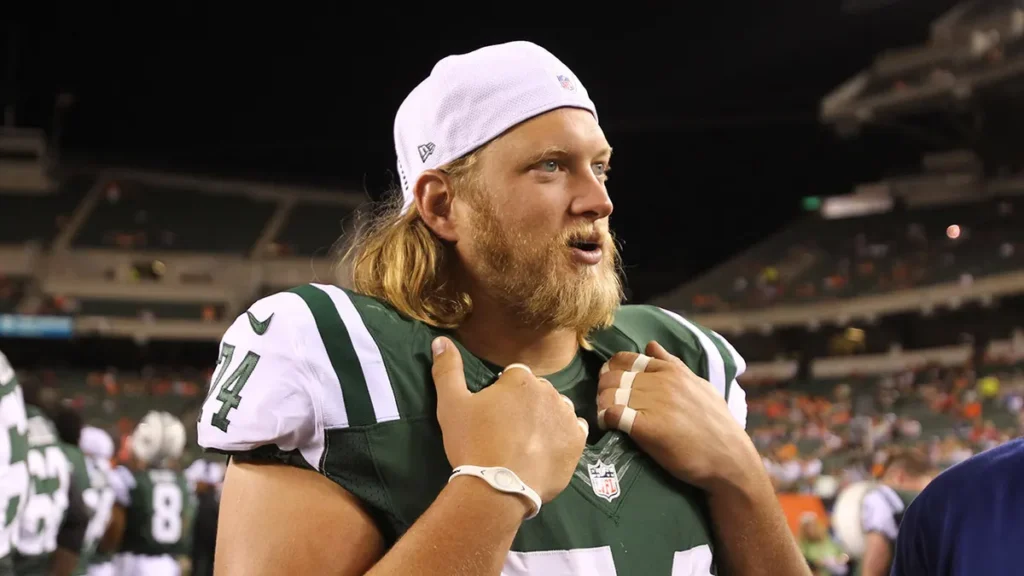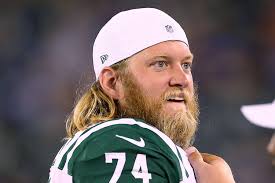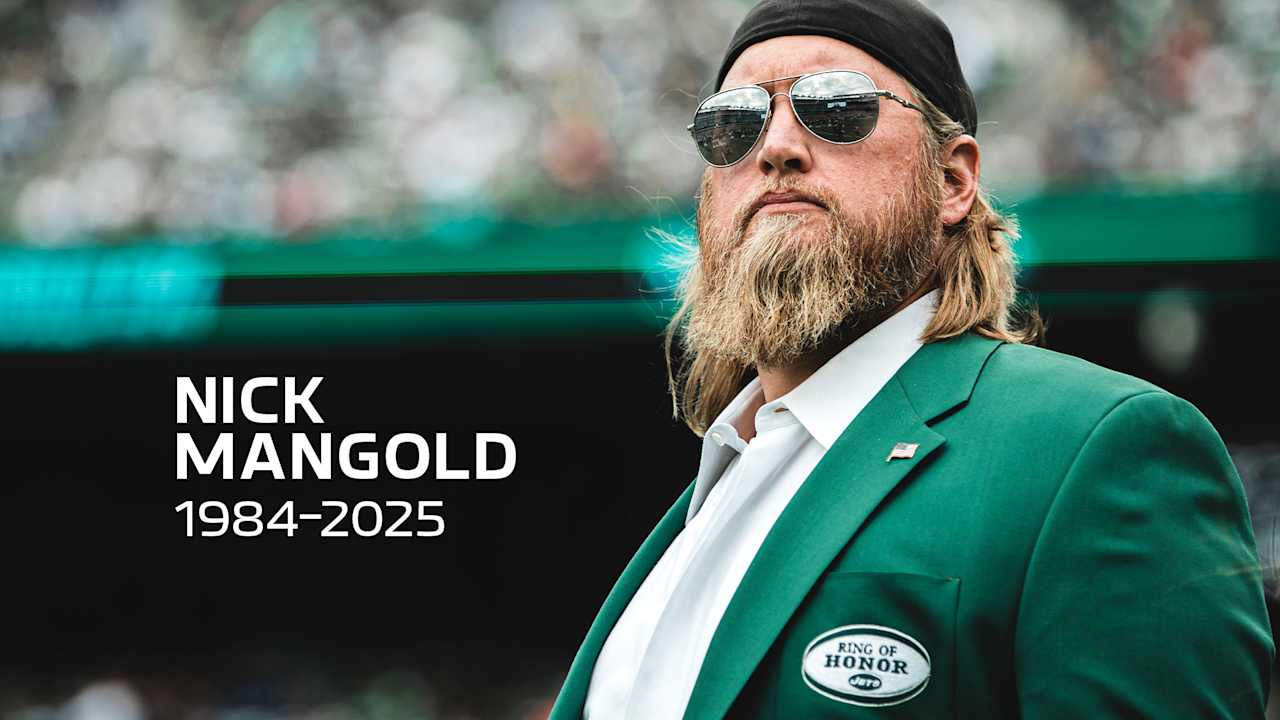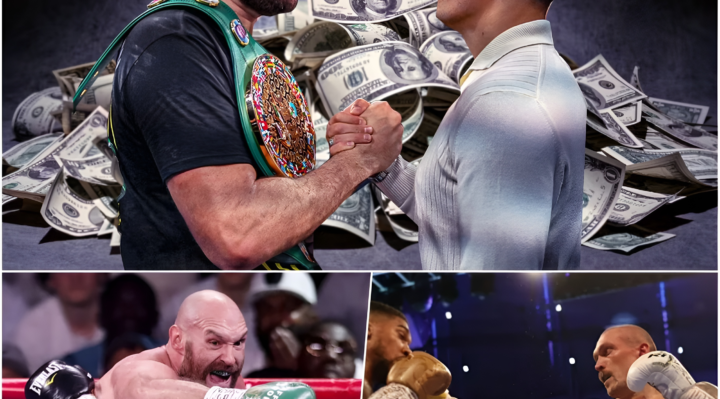Introduction: A Sudden Silence on the Gridiron
On October 25, 2025, the football world lost one of its quiet giants. Nick Mangold, the stoic center who anchored the New York Jets’ offensive line for over a decade, passed away at the age of 41 due to complications from chronic kidney disease. Just two weeks earlier, on October 14, Mangold had taken to social media with a raw, unflinching plea for a kidney donor, revealing a battle he’d waged silently since his 2006 NFL diagnosis.
“I always knew this day would come, but I thought I would have had more time,” he wrote, his words laced with the same matter-of-fact resolve that defined his playing days. “Most of all, I am thankful for my family, who have been my rock every step of the way. This situation has reminded me how lucky I am to have such incredible people in my life.”
Mangold’s death sent ripples through the NFL, from the hallowed halls of Ohio State University—where he honed his craft—to the raucous sidelines of MetLife Stadium, where Jets fans still chant his name during lulls in the action. Born on January 13, 1984, in the unassuming suburb of Centerville, Ohio, Mangold wasn’t the flashiest athlete.
He didn’t chase endorsements or spotlight interviews. Instead, he embodied the essence of the offensive line: invisible in glory, indispensable in grind. Over 11 seasons with the Jets, he started 159 of 164 games, earned seven Pro Bowl nods, and claimed two First-Team All-Pro honors. His line, often featuring the same five starters for 32 consecutive games, powered six top-10 rushing attacks and two AFC Championship appearances.
Yet Mangold’s story transcends stats and snapshots. It was a tapestry woven from Midwestern roots, Buckeye grit, and a post-retirement lifestyle that blended family hearth with quiet philanthropy. In Madison, New Jersey—his adopted home—he coached youth football, grilled with a passion that birthed his own BBQ sauce line, and savored simple joys: a Rangers game at Madison Square Garden, a Yankees outing in the Bronx, or chugging a beer during his 2022 Ring of Honor induction. “The diet is very different, your lifestyle’s different having to go through dialysis three times a week,” he reflected in one of his final interviews, turning even his health struggles into a testament to adaptability.
This article delves into Mangold’s NFL odyssey and the grounded life that followed—a narrative of a man who blocked for legends like Brett Favre and Mark Sanchez, then pivoted to fatherhood and fellowship without missing a beat. At over 6-foot-4 and 307 pounds, he was a gentle colossus, leaving behind a wife, four children, and a legacy as enduring as the snap count he called for 6,142 pass-blocking plays.

Roots in the Heartland: Early Life in Centerville
Nick Mangold’s beginnings were as solid as the pancakes he later flipped on NFL Sundays. Centerville, Ohio—a tidy enclave 10 miles south of Dayton—nurtured him amid cornfields and community bonfires. Born the eldest of four to Vernon and Therese Mangold, Nick grew up in a household where hard work was the family crest. Vernon, a high school teacher and coach, instilled discipline through Wee Elks youth football, where young Nick learned to read defenses before he could tie his cleats.
Therese, a pillar of quiet strength, balanced the home with her own athletic pursuits; their daughters—Kelley, Holley (an Olympic weightlifter who competed in Beijing 2008), and Maggey—added a layer of competitive fire. “Football was always there,” Mangold later recalled in a 2020 interview with Gang Green Nation. “My dad coached, my sister Holley threw weights around like they were pillows. It was in our DNA.”
Centerville High School, however, wasn’t the launchpad recruiters expected. Mangold attended Archbishop Alter High School in nearby Kettering, a Catholic powerhouse where he lettered in football, wrestling, and track. As a three-year starter on both sides of the ball, he earned All-Ohio honors as a senior, manning the line with a ferocity that belied his scholarly side. Off the field, he wrestled for three seasons, pinning opponents with the same leverage he’d later use against nose tackles, and hurled the shot put for two years, his throws echoing the power he’d channel into pulling blocks.
Yet, despite his dominance—leading Alter to a 10-2 record in his junior year—Mangold flew under the radar. No stars from Rivals.com or Scout.com; he was overlooked by big programs. That changed with an invitation to the 2002 U.S. Army All-American Bowl, where his snap precision caught scouts’ eyes. “I wasn’t the guy with the hype,” he quipped in a retirement reflection. “I was the guy who showed up and did the work.”
Those formative years shaped Mangold’s ethos: humility laced with hustle. Summers meant hay baling on family farms, winters wrestling mats slick with sweat. He balanced honors classes—acing biology and history—with weight room sessions that built his frame from lanky teen to gridiron fortress. Family dinners were strategy sessions; Vernon diagrammed plays on napkins, Therese quizzed him on angles. Holley’s weightlifting triumphs—snatching 200 pounds at 17—inspired Nick’s own pursuit of explosive strength. “Watching her lift was like seeing poetry in motion,” he said years later.
“It taught me that power isn’t just brute—it’s technique.” By graduation, Mangold was a three-sport letterman with a 3.8 GPA, bound for Ohio State on a scholarship that felt like destiny. Centerville wasn’t glamorous, but it forged a boy who prized consistency over spotlight, a trait that would define his 11-year pro tenure.
In Centerville, lifestyle was communal: block parties with grilled brats, Friday lights under the Knights’ banners. Mangold’s early “luxuries” were hand-me-down cleats and a shared family van for road trips to wrestling tournaments. This blue-collar backdrop instilled a frugality that persisted; even in the NFL, he’d opt for Long Island trains over limos. “Home was where the work ethic started,” he told Art of Fatherhood in 2020. “It wasn’t about stuff—it was about showing up.” Those roots grounded him through fame’s tempests, reminding him that true anchors don’t rust.
Buckeye Beginnings: Forging Steel in Scarlet and Gray
Ohio State University wasn’t just college for Nick Mangold—it was crucible. Arriving in Columbus in 2002 as a true freshman, he joined a Buckeyes program under Jim Tressel that demanded precision from its “Script Ohio” marching band to its trench warriors. At 6-4 and 285 pounds, Mangold backed up All-American center Alex Stepanovich, appearing in eight games that season. His snaps were crisp, his calls intuitive; offensive line coach Jim Bollman likened him to LeCharles Bentley, a Buckeye alum turned NFL star. “Nick had a natural feel for the position,” Bollman said. “He didn’t just block—he orchestrated.”
The 2003 knee injury to Stepanovich thrust Mangold into the spotlight. Starting the final 11 games, he shifted Stepanovich to guard upon return, cementing his role. Ohio State finished 8-5, but Mangold’s poise shone: zero sacks allowed in 400+ pass sets, per team logs. He majored in consumer sciences—practical, like his play—while logging 300+ minutes per game in film room and weight room. “College was where football became chess,” Mangold reflected in a 2020 YouTube sit-down with Mark Sanchez. “Every snap’s a decision. You learn to trust your eyes.”
By 2004, Mangold was a fixture, earning All-Big Ten Honorable Mention and Offensive Lineman of the Week honors seven times. Against Northwestern, he was named Offensive Player of the Week after pancaking linebackers on a 200-yard rushing day. The Buckeyes went 8-4, but Mangold’s line powered a ground game that averaged 150 yards per contest. His wrestling background aided in hand-fighting; track honed his burst off the line. Off-field, he bonded with future Jets like Mike Nugent and A.J. Hawk—Centerville connections in Columbus camouflage.
Senior year, 2005, brought second-team All-Big Ten nods. Starting all 12 games, Mangold anchored a 10-2 squad that crushed Notre Dame 34-20 in the Fiesta Bowl. He started 33 of 45 career games, a testament to durability rare for a 20-something. “OSU taught me resilience,” he said in his Gang Green Nation Q&A. “You face Michigan every year—hate week on steroids. Lose that, and you learn to bounce back.” Academically, he tutored linemen in nutrition, foreshadowing his post-career BBQ empire. Socially, Columbus was craft beer dives and Ohio Stadium roars; Mangold’s lifestyle stayed simple—dorm pizza runs, study groups—eschewing party scenes for extra reps.
Mangold’s Buckeye exit was understated: no Heisman hype, just 1,200 snaps of excellence. Scouts raved about his IQ—”He calls protections like a vet,” one noted—and footwork. “I left OSU knowing I could hang with pros,” he told NFL.com in 2021. “But it was the brotherhood that stuck—guys who bleed scarlet.” That foundation propelled him to the draft, where his unheralded high school path looped into lottery status. Ohio State didn’t just build a player; it sculpted a leader, whose line calls would echo from Columbus to Cortland.
The Draft Leap: From Buckeye to Big Apple
April 29, 2006: Radio City Music Hall buzzed as Commissioner Paul Tagliabue announced the New York Jets’ 29th pick. “The Jets select Nick Mangold, center, Ohio State.” In Green Bay, watching with family, Mangold exhaled—a first-rounder, the only center taken that high. Traded from Atlanta for edge rusher John Abraham, he joined D’Brickashaw Ferguson, the Jets’ fourth pick, in a rare double-dip on the line. “Surreal,” Mangold later said on SNY’s draft retrospective. “I thought maybe third round. Then New York? Talk about jumping in the deep end.”
Eric Mangini, the Jets’ cerebral head coach, saw Mangold as the “quarterback of the line.” At 22, Mangold inked a five-year, $14.25 million deal, stepping into a 7-9 squad desperate for trench stability. Rookie minicamp was baptism by fire: Chad Pennington’s quick releases, Curtis Martin’s stutter-steps. Mangold started all 16 games, allowing just 0.5 sacks and three penalties—numbers that earned PFWA All-Rookie Team honors. “He was plug-and-play,” Ferguson recalled in Mangold’s 2018 retirement presser. “Head spinning for me, but Nick? He learned formations overnight.”
The 2006 season was Mangold’s proving ground. Week 1 at Tennessee, he stonewalled Albert Haynesworth on a screen to Leon Washington. By midseason, his line calls stabilized a unit that rushed for 110 yards per game. A 23-17 upset over the Bills featured Mangold pulling for a 40-yard Leon bolt. Off-field, New York dazzled: subways to Manhattan steak houses, but Mangold and high school sweetheart Jennifer Richmond (whom he’d marry in 2007) kept it grounded. “We’d train-hop to the city, grab slices,” he shared. “Felt like home, but louder.”
Rookie year accolades were scarce for centers, but Mangold’s impact rippled. The Jets finished 10-6, snaring a Wild Card berth—their first playoffs since 2004. In the loss to New England, Mangold held firm against Tedy Bruschi, buying Pennington time for 271 yards. “That playoff fire? Addictive,” he told Sanchez in 2020. “Lost, but hooked.” Lifestyle-wise, he embraced the chaos: Yankees games, Rangers rinks, but always back to film study. Centerville simplicity met Gotham grit; Mangold’s anchor role was set.

Prime Time in Green: The Heart of the Jets’ Line
Mangold’s Jets tenure was a masterclass in consistency, peaking from 2007-2015 amid coaching carousels and quarterback quandaries. Under Mangini, then Rex Ryan’s blitz-happy regime, he became the constant—the snapper who turned chaos into cadence.
2007: All 16 starts, but a 4-12 skid tested resolve. Mangold allowed one sack, graded 85% by Pro Football Focus precursors. “Tough year, but you learn losing,” he reflected. 2008 brought Ryan, whose “ground-and-pound” fit Mangold like a glove. Paired with Brandon Moore and Alan Faneca, the line started 32 straight games—the NFL’s longest streak. Rushing leaped to 151 yards/game; Mangold’s first Pro Bowl followed a 34-0 rout of Arizona.
2009: Apex. The Jets surged to 9-7, clinching playoffs. Mangold’s blocks fueled Shonn Greene’s 1,100 yards. In the Wild Card thriller over Cincinnati (24-14), he neutralized Domata Peko. Divisional win at San Diego (17-14) featured that iconic 4th-and-1: Mangold’s combo block with Nick Kaczur sealed it. “We knew they’d load the box,” Mangold recounted in 2020. “Imposed our will—pure joy.” AFC Championship loss to Indy (30-17) stung, but his second Pro Bowl and First-Team All-Pro validated.
2010: Contract year magic. On August 24, Mangold signed a seven-year, $55 million extension—NFL’s richest for a center. “Felt like validation,” he said. The line, unchanged, ranked top-5 in run blocking. Playoffs redux: 24-19 over Favre’s Vikings (Mangold vs. old mentor), then that gut-wrench 24-19 Divisional loss to Pittsburgh. Second straight All-Pro; ranked 47th on NFL Top 100.
Injuries nipped 2011: High ankle sprain sidelined him two games, but he returned for a fourth Pro Bowl. 2012’s lockout-shortened prep yielded 8-8 mediocrity; no Pro Bowl, but 16 starts. Ryan’s final gasp in 2013: Fifth Pro Bowl, despite 8-8. Mangold’s IQ shone in protections for Geno Smith.
2014-15: Stability amid flux. Sixth and seventh Pro Bowls; the line rushed for 130+ yards annually. Against Buffalo in ’14, Mangold’s pull sealed Chris Ivory’s 39-yard scamper. “Those years? Peak form,” he told NFL.com. “Line calls like clockwork.” By 2016, age and ankle woes limited him to eight games; IR ended it.
Through it all, Mangold’s stats whispered excellence: 13 penalties in 11 years, one forced fumble (2007). Playoffs: 4 starts, zero sacks allowed. “Proudest? Consistency,” he emphasized. “Same guy daily—no lates in 11 years.” Teammates echoed: Revis called him “toughest,” Ferguson his “formation whisperer.” Ryan’s defenses thrived on Mangold’s ground game; six top-10 rush units. “He made us better,” Johnson said at retirement. Mangold’s prime wasn’t touchdowns—it was the unseen: 6,000+ snaps, turning scrums into surges.
Lifestyle during peak? Balanced. Weekdays: Cortland training camp grinds, film till midnight. Weekends: Jets’ holiday parties as Santa, signing autographs post-practice. With Jennifer and kids—Thomas (2010), Eloise (2012), Matthew (2014), and a fourth in 2016—he carved normalcy. “Football’s the job; family’s the why,” he told Art of Fatherhood. BBQ sessions with Ron Heller sparked his sauce venture; charity golf with Trump (2011) mixed politics and putts. Even in glory, Mangold stayed approachable—high-fiving Gov. Christie post-Super Bowl bid, toasting 9/11 flags at games. His Jets era was trench warfare won with quiet command.
The Art of the Anchor: Playing Style and On-Field Mastery
Centers are football’s unsung poets—quarterbacks without the huddle glory. Nick Mangold elevated the position to symphony conductor. At 6-4, 307, he blended leverage (wrestling roots) with vision (Buckeye film junkie). “It’s chess with shoulder pads,” he quipped in a 2010 Jets interview. His style? Smart aggression: quick sets to neutralize bull rushes, pulling like a freight train on sweeps.
Pass protection was surgical: 14 sacks allowed in 6,142 snaps (0.2%). Against elites like Vince Wilfork (2007), Mangold’s hand placement—low and locked—stifled A-gaps. Run blocking? Elite. 2010’s 151 yards/game owed to his second-level seals; Greene’s 1,100 yards rode Mangold’s pancakes. Penalties? 13 total—holding (11), false starts (3)—a 0.08% rate. “Discipline defined him,” PFF noted.
IQ set him apart. Line calls adjusted mid-play; in 2009 playoffs, he audibled protections vs. Cincy’s blitz. Durability: 97% start rate, despite 2011/16 ankles. “He never complained,” Revis said. Awards affirmed: Seven Pro Bowls (2008-11, 2013-15), three All-Pros (two First, 2011 Second). Ring of Honor 2022: “Anchor eternal.”
Mangold’s impact? Cultural. He mentored rookies like Molina, emphasizing prep. “Best effort daily,” his mantra. Offense flowed from his snap—Favre’s deep balls, Sanchez’s scrambles. “Nick made the line a unit,” Ferguson said. In an era of athletic QBs, his protection was priceless. Style-wise, he was the anti-diva: no tweets, just tape. “Football’s team; glory’s fleeting,” he reflected. His mastery wasn’t highlight-reel—it was the foundation that let stars shine.
Trials of the Trade: Injuries, Setbacks, and Steadfast Spirit
No career sans scars. Mangold’s bore ankle sprains (2011, 2016) and a 2006 kidney diagnosis—genetic IgA nephropathy, managed quietly till 2025. “Rough summer,” he posted October 2025. “Dialysis three times weekly—that’s a job.” Yet resilience ruled.
2011’s Week 2 tweak vs. Jacksonville: Out two games, returned vs. Pats for Pro Bowl. “Pain’s temporary; quitting’s forever,” he echoed Vernon’s mantra. 2016’s IR dash ended starts at 159. “Body said enough,” he admitted. Kidney-wise, drafts dodged disclosure; focus stayed football. “Lifestyle shift? Huge,” he told NY Post pre-passing. “Diet’s strict, energy dips—but mindset’s Jets: next play.”
Setbacks built depth. 4-12 seasons (2007, 2012) honed humility; playoff heartbreaks (2009-10) fueled fire. “Losses teach more,” he told Sanchez. Community buffered: Jets’ military parties, where he’d don Santa for kids. Family anchored—Jennifer’s support through transplants hunts. “She’s my MVP,” he gushed. Trials didn’t break; they burnished, proving Mangold’s spirit as unyielding as his blocks.
Signing Off: Retirement and the One-Day Farewell
February 25, 2017: Released to cap salary in rebuild. “Bittersweet,” Mangold said. Sat out 2017, pondering. April 17, 2018: Retirement announced. April 24: One-day contract, Jets forever. At Florham Park, with family, he reflected: “Miss the locker room, not the hits. Did it my way.”
Proudest? Accountability. “No lates, best effort—that’s legacy.” Johnson: “Stacks with greats.” Teammates lauded: Revis on grit, Ferguson on smarts. Post-script: 2019 OSU graduation, virtual game shows. “Football closed; life opened,” he beamed. Retirement wasn’t end—it was encore.

Beyond the Snap: A Life of Hearth, Heat, and Heart
Retirement unveiled Mangold unplugged: dad, grillmaster, giver. In Madison, NJ—post-Chatham move—he coached Pop Warner, teaching snaps to pint-sized pivots. “Seeing kids light up? Better than Pro Bowls,” he told Gang Green. Family core: Jennifer, met at Alter, wed 2007. Kids—Thomas, Eloise, Matthew, youngest girl—filled Sundays with chaos. “Fatherhood reframes everything,” per 2020 Art of Fatherhood. “NFL taught grind; kids teach grace.” Photos capture: Holding infant Matthew at Sanchez practices; family at retirement, Therese beaming.
Lifestyle? Eclectic ease. Rangers games: Taunting Penguins benches (2016). Yankees box: 2022 O’s clash. Charity: BTIG Day with Namath, Tuck; CC Sabathia’s softball with Strahan. BBQ passion bloomed via Heller: Big Green Egg gifts led to 74 Sauce—OG, Spicy, Honey (for Eloise), Fall Ya’ll (Carolina vinegar for youngest). “Portion to Answer the Call—honors fallen heroes,” he explained. Blind tastings validated; now four flavors, kid-inspired. “Grab my sauce downstairs? Perk of passion.”
Media dabbed: SiriusXM analyst, WFAN guest. 2025: Jets hopes chat—”Aaron Rodgers? Vintage wine.” Grilled series with Sanchez: Fajitas smoked, virtual feasts. “Mark inhales food; I plate art,” he joked. Community: NY Finest-Bravest games, 9/11 flags. 2022 Ring: Beer chug, fan salute. “New York’s home—tri-state love.”
Health shadowed: 2025 plea—”Thankful for rocks: family, Jets, Buckeyes.” Dialysis drudgery, yet optimism: “Better days ahead.” Tributes post-passing: OSU mourning—”Buckeye brother”; Jets: “Forever 74.” Legacy? Grounded giant, from Centerville fields to MetLife eternals.
Echoes of Excellence: Reflections and Enduring Legacy
Mangold’s voice, rare but resonant, dots interviews like perfect pulls. On career: “Proud I did it my way—learned from vets, passed to young guns.” Teammates: “Callahan? Genius. Ryan? Fire.” Moments: “4th-and-1 San Diego—will imposed.” Retirement: “Football done; life’s full.”
Post-NFL: “Cooking exploded—sauces for kids, good for causes.” Fatherhood: “Changes lens—grateful daily.” Health: “Jets mentality: next snap.”
Legacy? Hall Monitor 51.75—HOF fringe, but Jets icon. “Champions remembered,” NY Post eulogized. Tributes flood: “Gentle giant,” per Instagram reels. Ohio State: “Tragic, treasured.” Jets: Moment of silence vs. Bengals.
Mangold lived anchored: Career grit, life grace. “Lucky for people,” his last words. Indeed—football’s better for his blocks, world for his heart.




